Disease is a disorder of the body or the mind. Diseases affect almost all forms of life, including animals, plants, and one-celled organisms. In people and other animals, diseases are a major cause of suffering, disability, and death. Plant diseases destroy crops, reduce harvests, and ruin gardens. This article discusses human diseases.
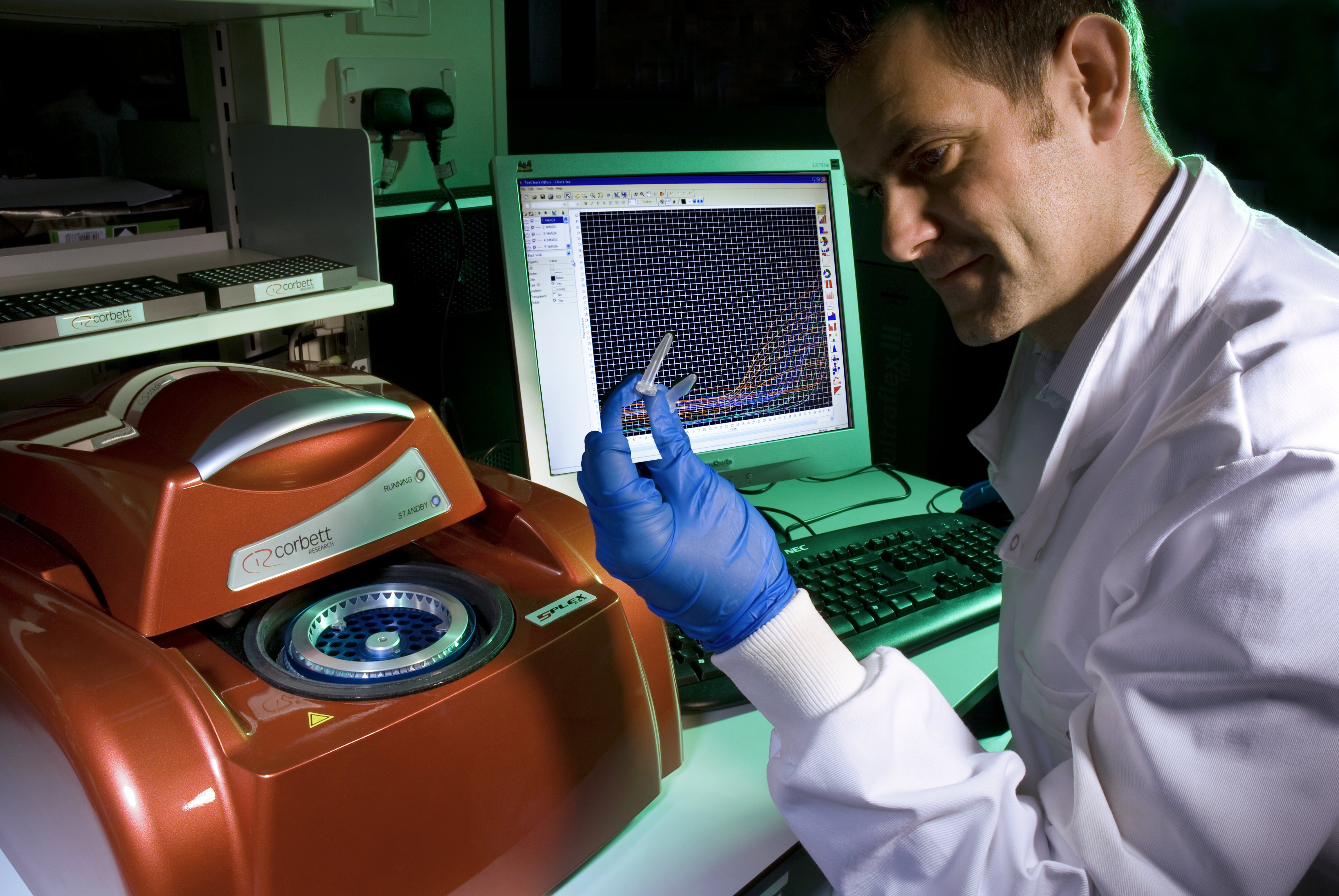
Human diseases may occur as sudden illnesses, as long-term disabilities, or as an unavoidable result of aging. All people experience diseases at some time in their lives, but individuals vary greatly in their likelihood of getting any particular disease. This variation is due to many factors, including age, environment, heredity, social conditions, stress, and a person’s general health.
Genes are one of the most important factors that influence health. Genes are chemical instructions that control how living things grow, develop, and function. Every human cell contains about 20,000 to 30,000 genes. Genetic instructions are so complicated that many mistakes can occur. Many of these errors can lead to diseases.
Attitudes about health also play an important role in disease. People can make many choices that help maintain health, including not smoking, exercising regularly, and eating a balanced diet. Stress, depression, and other emotional states can influence who becomes ill, how sick they feel, and how quickly they recover.
Ideas about health and sickness differ from one culture to another. In developed countries, many people who fall ill with colds or other minor illnesses stay home from school or work. They may seek a doctor’s attention and expect to receive drugs or other treatments. But in less developed nations, sick people may continue to work and meet other demands of daily life unless an illness completely disables them.
Diseases have existed since life began. Scientists have examined 2,000-year-old Egyptian mummies and found evidence of many of the same diseases that trouble people today. But diseases have also changed over time.
For most of human history, infectious diseases, such as plague, smallpox, and pneumonia, were the main cause of death and disability. In some cases, these diseases affected the course of history. For example, many historians think that smallpox was one factor that helped Spanish explorers conquer Indian civilizations of the Americas during the 1500’s. Smallpox did not exist in these civilizations until the Spanish unintentionally carried it with them from Europe. The disease swept through the Native American populations, making it easier for the Spanish to subdue them.
The first important advance against infectious diseases occurred in 1796, when British physician Edward Jenner developed the first vaccine—a vaccine against smallpox. During the 1800’s, doctors began to understand the importance of cleanliness and antiseptics in preventing the spread of infections. Widespread use of antibiotics during World War II (1939-1945) was another important milestone in progress against infectious diseases. In the years following their introduction, antibiotics were commonly known as “wonder drugs” because their effect on serious infections was so dramatic.
In 1980, the World Health Organization announced that smallpox had been eliminated from the earth. But other infectious diseases continue to create problems. In some cases, the microorganisms that cause these diseases have developed the ability to resist the effects of antibiotics. Infections that become resistant to antibiotics may pose a renewed threat to world health.
As vaccines, antiseptics, and antibiotics helped people survive infectious diseases, life expectancy increased. Improved public sanitation and better standards of living also helped extend the average life span. According to the World Health Organization, most people in the mid-1900’s did not live past the age of 50. Today, worldwide average life expectancy is about 65 years, and many people live even longer. Extended life has brought new importance to the diseases of aging. In many countries, most death and disability are now due to such ailments as arthritis, cancer, heart disease, and osteoporosis.
Changes in the way people live have also affected worldwide patterns of disease. For example, high-speed international travel provides a means for disease to spread much more quickly than in the past. Doctors first recognized AIDS as a “new” disease in the United States during the early 1980’s. Within a decade, AIDS had become a global epidemic.
Scientists recognized additional new diseases during the late 1900’s. A virus called rotavirus, first identified in the early 1970’s, is one of the chief worldwide causes of diarrhea in children. Other newly recognized diseases include a type of pneumonia called Legionnaires’ disease and Lyme disease, an infection transmitted by ticks.
Experts around the world work constantly to understand how diseases change and how these changes may affect human health. Researchers study patterns of infections, population shifts, and social changes. They explore new insights into such matters as the role of genes, the influence of the environment, and the effects of aging. With these efforts, scientists hope to preserve past gains over disease and ensure future successes.
Infectious diseases
Infectious diseases, also called infections, occur when an organism or other agent gains entry to the body and reproduces itself. Infectious agents are also called pathogens << PATH uh juhnz >> or, commonly, germs. Some pathogens damage or destroy the cells or tissues in which they reproduce. Others produce toxic chemicals that harm the body. In some cases, the body’s response to infection damages its own tissues.
Infectious diseases can be grouped according to the type of agent that causes them. Bacteria and viruses are the most common pathogens. Other pathogens include fungi, protozoans, and worms.
Bacterial diseases.
Bacteria are microscopic, one-celled organisms that rank among the most widespread of all living things. Enormous numbers of bacteria live almost everywhere in the world. A small sample of soil may contain millions of these microorganisms.
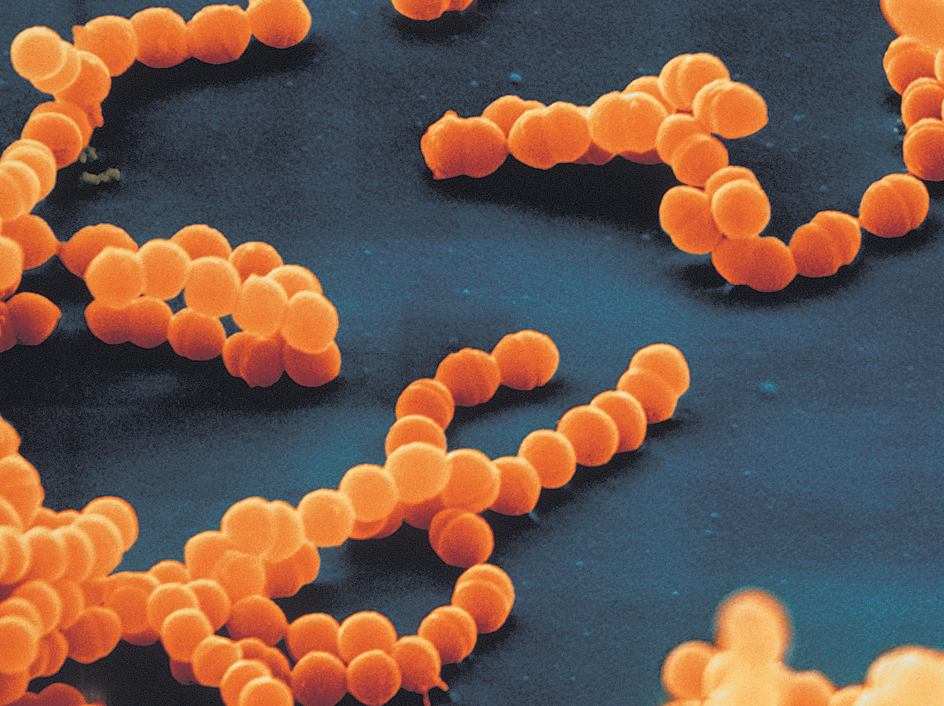
Most bacteria do not cause disease. Many kinds—called resident bacteria—live harmlessly on the skin or in the human mouth and intestines. These resident bacteria help protect people by crowding out or killing many disease-causing bacteria. Resident bacteria seldom cause disease unless they move to an organ where they are not normally present. For example, bacteria that live harmlessly in the mouth can cause infection if they enter the bloodstream and begin growing on a damaged heart valve.
Most bacterial diseases result when bacteria multiply rapidly in living tissue. As they multiply, the bacteria release substances called enzymes that cause inflammation and damage or destroy living tissue. The body’s response to invading bacteria also contributes to inflammation. This inflammation causes many of the familiar symptoms of disease, including cough, diarrhea, discharge, and pain.
For example, the redness and pus of pimples occur when a weak bacterium called Propionibacterium acnes << `proh` pee ON uh bak TIHR ee uhm AK neez >> multiplies in the oil glands of the skin. A bacterium called Mycobacterium tuberculosis << `my` koh bak TIHR ee uhm too `bur` kyuh LOH sihs >> can multiply in the lungs and cause the cough associated with tuberculosis. The bacterium Chlamydia trachomatis << kluh MIHD ee uh truh KOM uh tuhs >> causes a sexually transmitted disease that is commonly called chlamydia. Symptoms of chlamydia may include sore throat, pneumonia, painful urination, discharge from the sex organs, and blindness.
Some bacteria cause disease by producing poisonous substances called toxins. One such disease is tetanus << TEHT uh nuhs >>. Tetanus is caused by the bacterium Clostridium tetani << klahs TRIHD ee uhm TEHT uh ny >>, which normally lives in soil. If it enters the body through a wound, the bacterium makes a toxin that causes violent muscle contractions. A bacterium called Clostridium botulinum << klos TRIHD ee uhm BOCH uh lihn uhm >> can multiply in food and produce a deadly toxin. This toxin causes botulism << BOCH uh lihz ihm >>, a type of food poisoning that paralyzes muscles throughout the body.
Viral diseases.
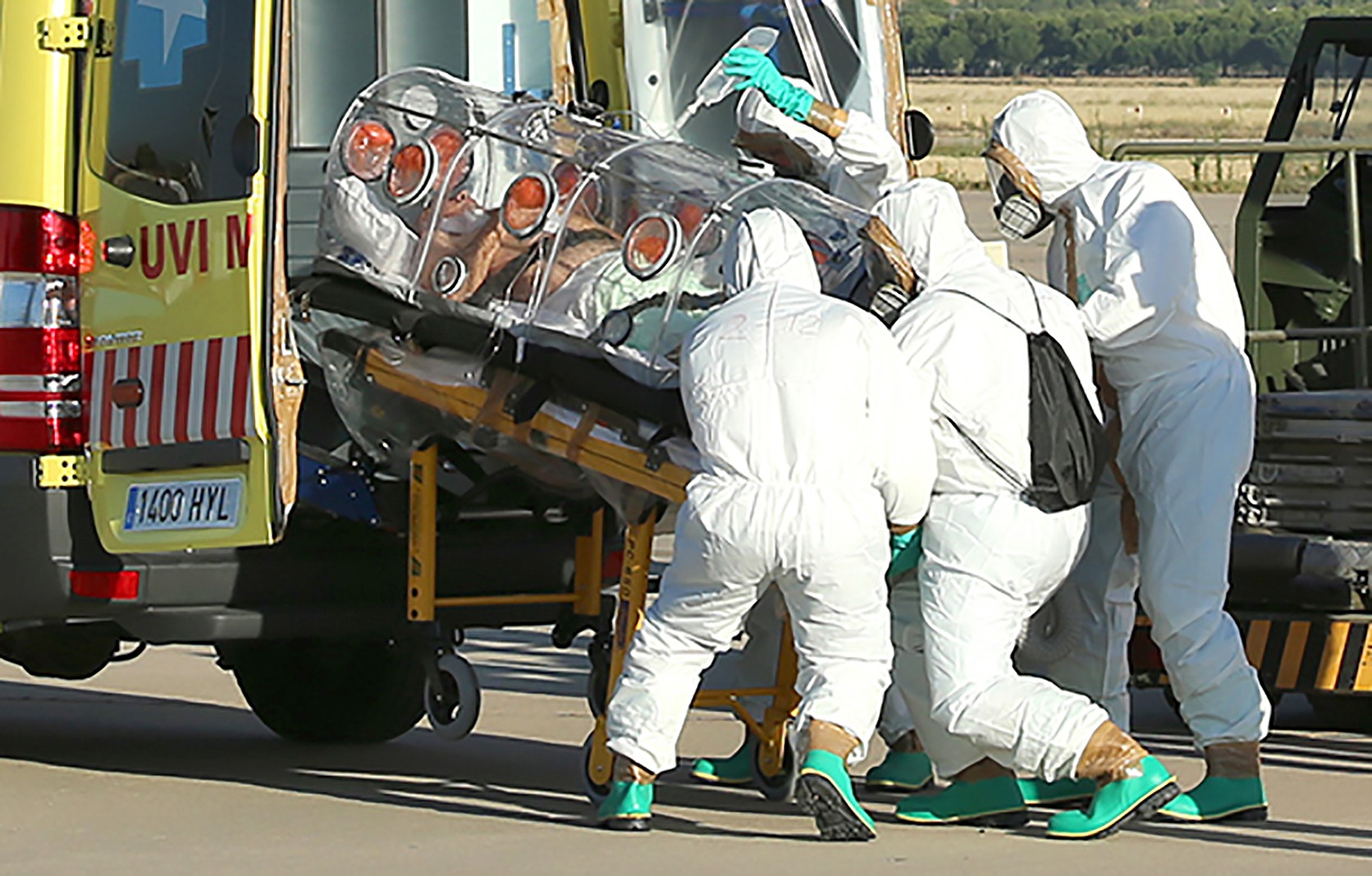
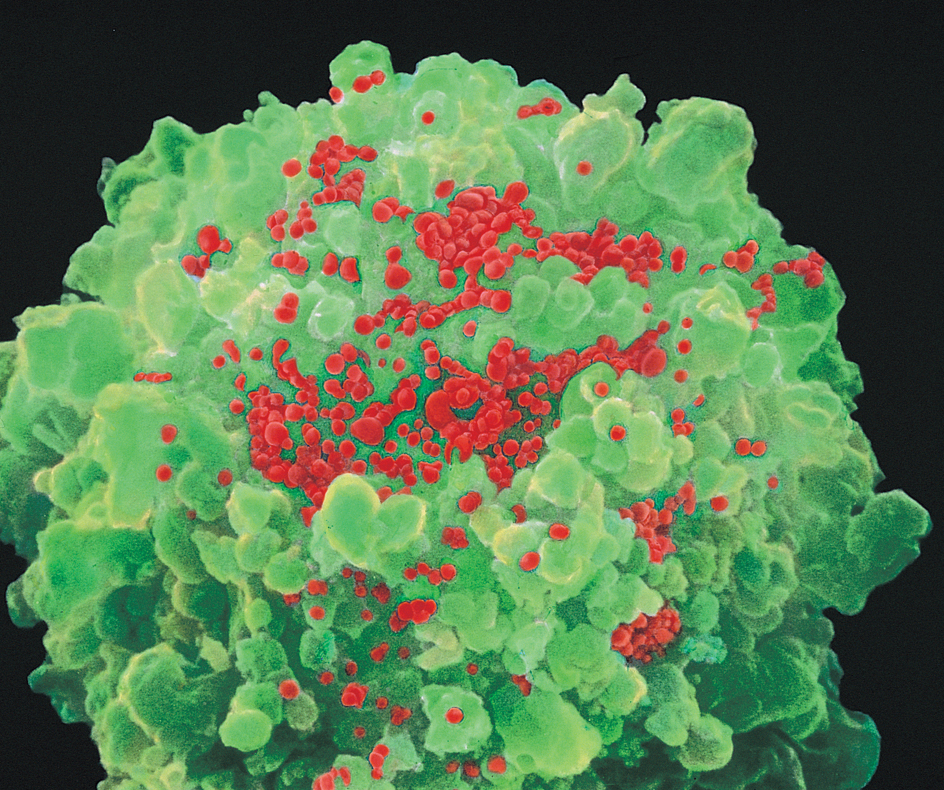
Some of the most familiar diseases—including influenza and the common cold—are caused by viruses. Viruses also cause chickenpox, measles, mumps, and rubella (also called German measles). Most cases of diarrhea and vomiting result from viral infections.
Such serious diseases as hepatitis, polio, rabies, and AIDS are also caused by viruses. HIV, the virus that causes AIDS, reproduces within certain cells of the immune system and weakens the body’s ability to resist diseases. As a result, people with AIDS fall ill with diseases that do not normally occur or that are not usually serious. Many people with AIDS die from these illnesses that take advantage of the body’s weakened immune system.
Other infectious diseases
can be caused by fungi, protozoans, or worms that live in or on the human body. These pathogens cannot make their own food—they obtain nourishment by breaking down body tissues or by absorbing digested food from the intestines. Diseases caused by these pathogens range from minor skin infections to life-threatening disorders.
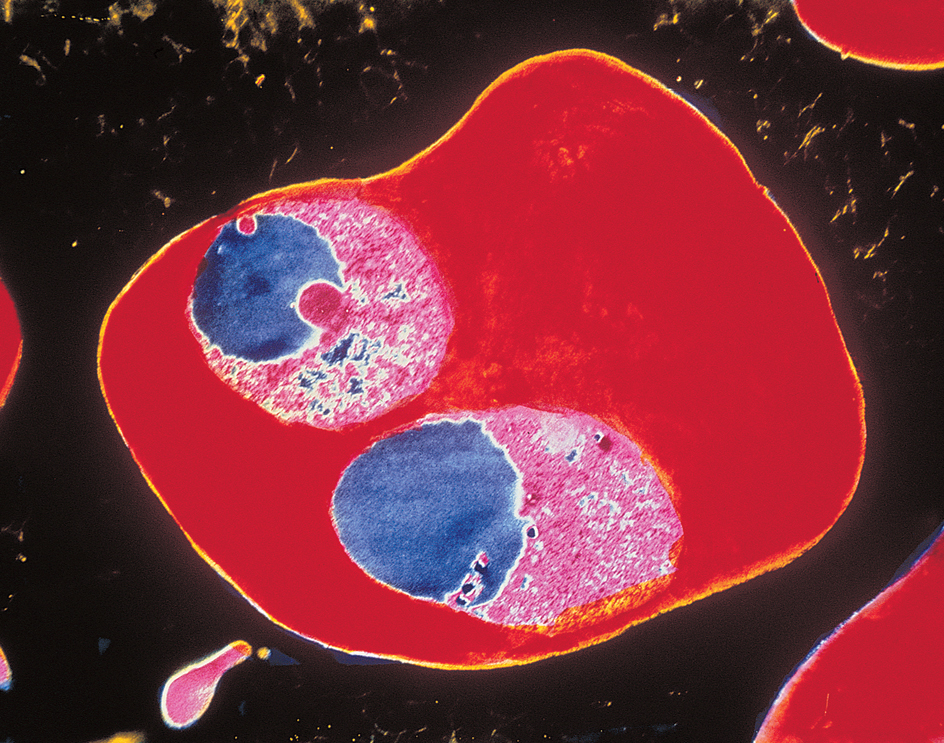
Most fungi are weak pathogens that are normally present in small numbers on the skin or in the intestines or other organs. Common fungal infections include such skin disorders as athlete’s foot and ringworm.
Serious fungal infections are uncommon in otherwise healthy people. People who have other health problems or weakened immune systems, however, may develop fungal infections that spread throughout the body. Some fungi can cause meningitis << `mehn` ihn JY tihs >>, an infection of the membranes that line the brain. Fungi also cause a potentially serious disease of the lungs called histoplasmosis << `hihs` tuh plaz MOH sihs >>.
Protozoans are another type of one-celled organism. Disease-causing protozoans occur throughout the world. Protozoans called Plasmodia << plaz MOH dee uh >> cause malaria, which ranks among the greatest worldwide causes of death and suffering. A protozoan called Toxoplasmosis gondii << tok suh plaz MOH sihs GOND ee eye >> can be fatal in people whose immune system is weakened by cancer or AIDS. An increasingly common protozoan called Giardia lamblia << jih AR dee uh LAM blee uh >> causes severe, long-lasting diarrhea.
Loading the player...Malaria growth
Flatworms and roundworms are among the worms that cause human disease. Disease-causing flatworms include flukes, which can invade the blood, intestines, liver, or lungs; and tapeworms, which live in the intestines. Disease-causing roundworms include hookworms and pinworms. Worm infections cause many serious tropical diseases, including elephantiasis << `ehl` uh fuhn TY uh sihs >> and river blindness.
Spread of infectious diseases.
Infectious diseases vary greatly in how easily they spread among people. An unusually contagious illness that sweeps through a community or an entire continent is called an epidemic. An epidemic that travels rapidly from one continent to another is called a pandemic. A major pandemic occurred during the winter of 1918-1919, when an outbreak of unusually deadly influenza swept the world. Infectious diseases that are always present in a particular region are called endemic to that region. For example, malaria is endemic to the jungles of Asia and Africa.
Some of the important ways that infectious diseases are spread include (1) by people, (2) by animals, (3) by water, (4) by food, and (5) by nonliving sources
By people.
Many common diseases travel directly from a person who has the disease to other people. Illnesses that spread by direct person-to-person contact are called communicable. Examples of communicable diseases include AIDS, colds, hepatitis, influenza, pneumonia, strep throat, and tuberculosis.
Many infections spread from one person to another on hands. People often catch colds and other viral illnesses when their hands carry the virus to membranes in their eyes or nose. Doctors have known for more than 100 years that thorough hand washing helps prevent the spread of disease. Infections are also spread from person to person by coughs, sneezes, and sexual contact.

By animals.
Some infectious diseases are spread by insects and other animals, especially blood-sucking insects, such as mosquitoes and fleas. Mosquitoes rank among the most serious threats to public health. They spread malaria, yellow fever, encephalitis, and other deadly ailments. Fleas carry some types of plague. Before antibiotics, epidemics of plague swept through the world periodically and killed millions of people. Ticks, which are related to spiders, can transmit Lyme disease, Rocky Mountain spotted fever, and other illnesses.
A few infectious diseases are spread by infected birds or mammals. One example is rabies, a virus that can infect bats, cats, dogs, raccoons, skunks, and other mammals. The bite of an infected animal can transmit rabies to people. A disease called psittacosis << `siht` uh KOH sihs >> or parrot fever can pass from infected birds to people.
By water. Dirty drinking water remains a major cause of disease in many parts of the world. Some less developed nations lack the resources to provide citizens with sewerage systems, water purification, or toilet facilities. As a result, human waste enters the drinking water and spreads bacteria, worms, and protozoans. These pathogens cause widespread diarrhea and other intestinal disorders. Outbreaks of diseases carried by water also occur occasionally in developed countries, often when sewage unexpectedly enters community water supplies.
By food.
Many foods can nourish pathogens just as effectively as they nourish people. Bacteria, such as E. coli << EE KOH ly >>, campylobacter << `KAM` pih loh BAK tuhr >>, or salmonella << `sal` muh NEHL uh >>, can grow and reproduce in such foods as chicken, beef, or mayonnaise. Many pathogens transmitted in foods cause vomiting, diarrhea, and other intestinal disturbances.
By nonliving sources.
Objects spread less disease than people, animals, food, or water do. But some pathogens survive long enough to pass from person to person on nonliving things. For example, scientists have found that kitchen sponges and dishcloths contain surprisingly large numbers of pathogens. The United States Food and Drug Administration recommends that people sterilize or replace sponges and dishcloths regularly.
Noninfectious diseases
Noninfectious diseases are an extremely broad group of illnesses that are not caused by pathogens. Important categories of noninfectious diseases are (1) inherited diseases, (2) cancer, (3) metabolic diseases, (4) disorders of the immune system, (5) environmental and occupational diseases, and (6) diseases associated with aging.
Inherited diseases
involve defects in genes that can be passed from one generation to another. In some cases, the role of such genes is well understood and clearly defined. For example, anyone who inherits the gene for Huntington’s disease eventually gets this fatal disorder of the nervous system. Likewise, anyone who inherits the sickle hemoglobin gene from both parents develops sickle cell anemia, a serious blood disease.
Many other diseases—for example, high blood pressure and heart disease—run in families. But there is no set pattern to how they occur. Scientists suspect that many such conditions involve inherited genes, but the particular defective genes have not yet been identified. In some diseases, researchers think that more than one gene is involved. In other diseases, a gene with an inherited defect must be further damaged by chemicals, viruses, or other factors before it causes an illness.
Some diseases occur because human genes adapt people to ways of life that no longer exist. For example, bodily processes that occur as a response to stress helped people fight or flee real physical dangers in prehistoric times. People today still have stress reactions, but most of the challenges that modern people face are mental and emotional. Stress is a much less useful response to such challenges than it is to physical threats. In addition, stress places heavy demands on the body. Many doctors estimate that stress is involved in more than half of all illnesses. Ailments in which stress often plays an important role include headaches, chest pains, muscle aches, and stomach upsets.
Cancer
is one of the most common and feared diseases throughout the world. It occurs when cells in the body multiply without control. Cancer can begin in almost any type of cell. Cancer cells invade and eventually destroy surrounding normal tissue. In addition, cells from the original cancer can spread and form more cancers in distant parts of the body. If left untreated, most types of cancer are fatal.
Cancer arises from defects in the genes that control cell growth and division. Some people inherit such defective genes. For example, scientists have identified certain inherited abnormal genes that greatly increase the risk that a person will develop breast or colon cancer.
Most people who develop cancer have not inherited genetic defects. Their genes have been damaged after birth by chemicals, radiation, viruses, or other substances in the environment. One of the most common—and most avoidable—causes of cancer is cigarette smoke. Scientists estimate that one-third of all cancers arise from genetic damage due to smoking.
Metabolic diseases
result from disturbances in the metabolism, the complex system of chemical processes by which the body nourishes, maintains, and regulates itself. These processes control how the body stores and releases the energy needed to grow, to maintain tissues, or to repair them. Metabolic diseases may arise chiefly as a result of poor nutrition or endocrine disorders.
Poor nutrition.
Food provides the raw materials needed for metabolism. Important steps in metabolic processes cannot occur if a person’s diet lacks enough sugars, proteins, fats, vitamins, or minerals. For example, children who eat too little protein may develop a disease called kwashiorkor << KWAH shee `awr` kawr >>. Children with kwashiorkor fail to grow because proteins provide the building blocks for body tissues.
Even when food is plentiful, people may not eat enough of the right foods. People throughout the world commonly take in too little of the mineral calcium, which is needed to keep bones strong. Lack of calcium contributes to a condition called osteoporosis, in which bones gradually become thin and brittle as people grow older. Fractures due to osteoporosis are a major cause of suffering and death in elderly people.
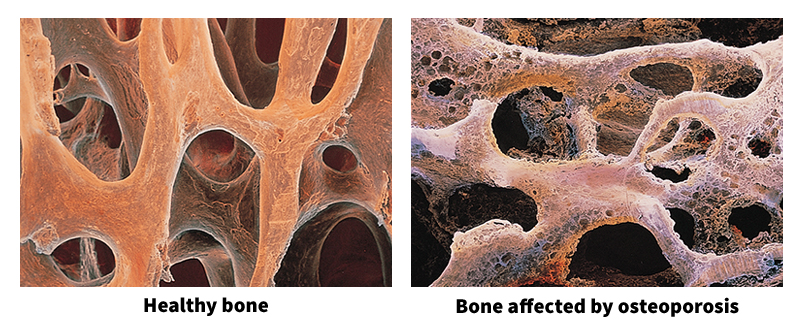
In developed countries, many people become overweight by eating too many calories and too much fat. Excess weight puts extra demands on the body and can disturb metabolism. For example, many overweight people have too much fat circulating in their blood. High levels of blood fats increase the risk of heart disease.
Endocrine diseases
are caused by malfunctions in the body’s system for regulating metabolism. Much of this regulation is accomplished by hormones, chemicals that are produced in one part of the body but affect one or more other parts. Most hormones are made in structures called glands.
One of the most common endocrine diseases is diabetes mellitus << `dy` uh BEE tihs or `dy` uh BEE teez MEHL uh tuhs >>. Diabetes is a serious disorder involving the hormone insulin. Insulin is produced by the pancreas, which acts as both a gland and a digestive organ. Insulin enables cells to use and store sugar as a source of energy. In some cases of diabetes, the pancreas does not produce enough insulin. In other cases, insulin is produced, but the body’s cells resist its effects. Being overweight increases the risk of diabetes because excess weight is one cause of insulin resistance.
Diabetes severely affects cells throughout the body. Cells that cannot use sugar may starve and die. Other cells are damaged by high levels of sugar that build up in the blood. As cellular damage accumulates, diabetes can cause disability and death.
Disorders of the immune system.
The immune system consists of cells, molecules, and tissues that work together to defend the body against infections, cancer, and other invaders. In rare cases, children are born with defective immune systems that cannot defend them properly. Many such children do not survive without special drugs, surgery, or bone marrow transplants.
Most immune disorders occur because of flaws in the immune system’s ability to recognize harmful substances. The most common immune disorders are allergies, including asthma, hay fever, and hives. Allergies occur when the immune system reacts to a substance in the environment as if it were a dangerous invader. Common causes of allergies include pollens, molds, animals, house dust, and foods. Allergic reactions can range from a runny nose and itchy eyes to a fatal shutdown of body systems.
Autoimmune diseases are another common immune disorder. In these diseases, the immune system attacks the body’s own tissues as if they were foreign invaders. Autoimmune diseases can affect tissues and organs throughout the body. One serious autoimmune disease is systemic lupus erythematosus << sihs TEHM ihk LOO puhs `ehr` uh `thehm` uh TOH sihs >>, often shortened to SLE. SLE can attack the heart, lungs, skin, nerves, eyes, kidneys, and other organs.
Environmental and occupational diseases.
Environmental diseases result from substances in the air, water, or other surroundings. Such disorders are called occupational diseases when they are caused by factors associated with a particular workplace.
Air pollution is a common environmental cause of disease. Air pollution can irritate the eyes, nose, and throat. Many lung problems, including asthma and infections, are made worse by dirty air. When air pollution reaches extremely high levels, scientists advise people to avoid outdoor activity—especially vigorous exercise.
Noise is another common pollutant in modern life. Prolonged exposure to loud noise can lead to hearing loss. Noise pollution also contributes to development of stress-related illnesses.
People expose themselves to some environmental agents through their own habits. For example, cigarette smokers inhale many chemicals and particles that cause cancer, heart disease, and other ailments. Smokers also endanger the lives of nonsmokers around them. Breathing another person’s cigarette smoke raises risk of cancer and heart disease.
The habits of pregnant women affect not only themselves but also their unborn babies. A mother’s smoking can hinder her baby’s ability to gain weight and cause other health problems. Exposure to drugs or alcohol before birth can also interfere with normal development.
Some occupations expose workers to harmful environments. The mineral asbestos is a well-known cause of occupational disease. Asbestos was once widely used for manufacturing, packaging, insulating, and other purposes. But health problems in people who worked with asbestos gradually revealed the deadly consequences of breathing its fibers. Scientists now know that inhaling asbestos scars the lungs badly. In addition, the mineral causes cancer of the lungs and of the tissues that line the chest and abdomen. Many countries now limit exposure by requiring that asbestos workers wear protective clothing and breathing devices.
Repetitive strain injuries (RSI’s) are occupational diseases of growing importance. RSI’s are painful disorders caused by performing a similar movement over and over again. A wide range of occupations—from computer programming to meat cutting—pose a risk of RSI’s. A wrist disorder called carpal tunnel syndrome is the most common such injury. Experts in ergonomics << `ur` guh NOM ihks >> seek ways to prevent these disorders. Ergonomics is the science of designing machines, objects, and physical environments to match the needs and abilities of human beings.
Diseases associated with aging
involve gradual breakdown of cells, tissues, and organs as people grow older. No one can avoid all diseases forever, because some disorder eventually causes everyone’s body to fail and die. But several factors influence how soon people’s bodies begin to show signs of age. Genes have some effect on which diseases people get and on the age when they tend to get them. People can delay or avoid development of some diseases through a balanced diet, exercise, not smoking, and other good health habits.
Cardiovascular diseases,
which affect the heart and blood vessels, are a leading cause of death around the world. Some cardiovascular disorders develop and worsen over the course of many years. For example, atherosclerosis << `ath` ur oh skluh ROH sihs >> is a disease in which fatty deposits gradually build up on the inside walls of arteries. The deposits interfere with the flow of blood and can lead to heart attacks and strokes. Almost everyone develops some degree of atherosclerosis as they age. But people can help control atherosclerosis by exercising and limiting the amount of fat they eat.
Hypertension (high blood pressure) is another long-term disorder that contributes to strokes and heart attacks. Blood pressure that is too high increases the heart’s workload and puts extra strain on blood vessels. Doctors often call hypertension “the silent killer” because it rarely causes symptoms until after it has caused widespread damage to the heart and blood vessels. But a doctor can easily diagnose high blood pressure with a simple examination. In many cases, drugs or changes in diet can lower the blood pressure to safe levels.
Heart attacks or strokes may strike after years of atherosclerosis or hypertension damage the heart and blood vessels. A heart attack usually occurs because an artery to the heart suddenly becomes blocked. As a result, part of the heart does not receive enough oxygen-rich blood and dies. Many heart attacks—including first attacks—are fatal. But many people also survive attacks that affect only a small portion of the heart. People who have had a heart attack can improve their health and help avoid additional attacks with a cardiac rehabilitation program. Such programs may include a low-fat diet, increased levels of exercise, and drugs to reduce blood fat.
A stroke occurs when part of the brain does not receive enough blood. The affected portion may be permanently damaged. Some strokes are fatal. Others cause various disabilities, depending on the area of the brain that is damaged. Common problems include paralysis and loss of speech. In some cases, undamaged areas of the brain eventually take over some lost functions. But many stroke patients are left with permanent disabilities.
Arthritis
is a general term for diseases that affect the joints and muscles. Two widespread forms of arthritis are rheumatoid arthritis << `roo` muh TOYD ahr THRY tihs >> and osteoarthritis << `ahs` tee oh ahr THRY tihs >>. Rheumatoid arthritis causes pain and swelling in joints throughout the body. It can strike people of any age, but it is most common in middle-aged women. The cause of this type of arthritis is not known. Osteoarthritis, the most common form of arthritis, affects millions of older adults. This disorder results from wear and tear on the joints, especially those of the knees, hips, lower back, and fingers. The pain of osteoarthritis forces many older people to limit their movements and activities. Surgical replacement of joints can provide relief in some cases.
Degenerative diseases of the brain
are caused by gradual destruction of brain cells. One common condition is Alzheimer’s << AWLTS hy murz >> disease, which chiefly affects people over the age of 60. In Alzheimer’s disease, excessive amounts of proteins called amyloid << AM uh loyd >> build up in brain cells and kill them. As more cells die, people become unable to remember or make judgments. Alzheimer’s patients eventually become bedridden and cannot care for themselves. Doctors do not yet know what causes Alzheimer’s disease, but many cases appear to involve genetic factors.
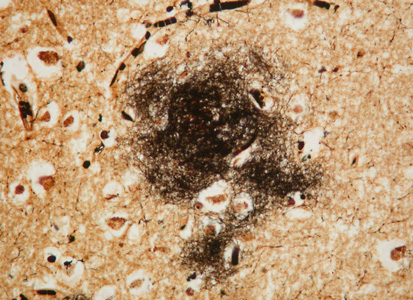
Fighting disease
Medical scientists have learned a great deal about how the body defends itself against illness. Two of the chief defenses that the body uses are natural barriers against pathogens and immune responses. Medical treatment helps people overcome a wide range of diseases that the body cannot conquer without help.

Natural barriers
are physical or chemical obstacles that prevent pathogens from entering the body. For example, tears wash foreign substances from the eyes and contain proteins that destroy many common pathogens. One of the most effective physical barriers is unbroken skin, which few pathogens can penetrate.
Sheets of tissue called mucous membranes form barriers on many internal body surfaces. These membranes are covered with mucus, a sticky fluid that catches many pathogens. In addition, mucous membranes release protective chemicals. For example, mucous membranes that line the nose and mouth trap many pathogens. The body then expels the invaders by sneezing or coughing.
Mucous membranes in the breathing tubes, the bronchi << BRONG ky >>, play an important role in protecting the lungs. Most cells in the bronchi have tiny hairlike projections called cilia << SIHL ee uh >>. Cilia move in coordinated waves that push mucus and trapped pathogens out of the bronchi, up the windpipe, and into the mouth. Mucus that reaches the mouth can then be harmlessly swallowed. When swallowed pathogens reach the stomach, many are destroyed by acid digestive juices.
Resident bacteria that live harmlessly on the skin, in the mouth, and in the intestines provide another barrier against disease. They crowd out many pathogens that might otherwise flourish. Resident bacteria also produce substances that kill or damage certain pathogens.
Immune responses
defend against pathogens that get past the body’s natural barriers. These responses are the body’s most powerful weapons against disease. In an immune reaction, cells, molecules, and chemical messengers work together to identify and overcome foreign invaders. The immune system also helps fight cancer cells that develop within the body. People’s immune systems differ in effectiveness due to heredity, stress, previous illnesses, and other factors.
White blood cells are a key part of the immune system. Certain white blood cells patrol for pathogens as they circulate through the body. One such group of scouts are called phagocytes << FAG uh sytz >>. Their name comes from the Greek word for eat. Phagocytes surround and digest bacteria and infected cells, then display fragments of the digested invaders on their surface. The phagocytes then “present” these fragments to another group of patrolling white blood cells called T-helper cells.
When phagocytes and T-helper cells meet, they release chemicals that strengthen the immune response. One important group of immune-system chemicals are proteins called interferons << `ihn` tur FIHR onz >>. Interferons are one of the body’s chief defenses against viruses. Cells infected with viruses also produce interferons. These proteins hinder viral infections by binding to healthy cells and preventing viruses from entering them.
Some other chemicals signal blood vessels at the site of the immune reaction to begin leaking fluids and cells. The fluids contain additional substances that help fight the invading pathogens and attract more white blood cells. Still other chemicals signal the body to raise its temperature. A fever increases the rate of chemical reactions in the immune system and speeds the movement of white blood cells. Some researchers also think fever directly kills or weakens certain pathogens.
After T-helper cells meet phagocytes, they activate additional types of white blood cells. When T-helper cells activate white blood cells called B cells, these cells release proteins called antibodies. Antibodies attach themselves to pathogens and toxins. This attachment may either kill the invaders or make them harmless. For example, some antibodies coat bacteria and make them clump together. The clumped bacteria attract phagocytes and are easier for them to digest.
T-helper cells also activate another type of T cell called cytotoxic << `sy` tuh TOK sihk >> T cells, commonly known as killer T cells. Killer T cells destroy diseased cells, including cancerous cells and ones infected with viruses. White blood cells called natural killer cells are another important weapon against cancer.
After the body has successfully overcome an infection, white blood cells called memory T cells and memory B cells “remember” the infection. This ability enables the body to develop long-term protection—called immunity—to many infectious diseases. For example, the immune system remembers the measles virus after a person has had measles. The next time that virus strikes, memory cells will begin a rapid response that destroys the virus before it causes illness.
Medical treatment.
Efforts to treat disease have played an important role in life since ancient times. Early healers knew little about the body and had no understanding of the real causes of illness. Knowledge of the body and its ailments increased gradually over the centuries, then grew rapidly during and after the Renaissance, which lasted from about the 1300’s to the 1600’s. Today, doctors and other health professionals can offer a vast range of treatments to fight disease.
To provide successful treatment, doctors must correctly diagnose (identify) a disease. Accurate diagnosis relies heavily on the skill of a physician because many diseases cause similar symptoms. Doctors first ask patients about their current symptoms and how the symptoms developed. The doctor also inquires about the medical history of the patient and family members. An office examination can reveal much about a patient’s basic condition, including body temperature, blood pressure, pulse, and heart and lung sounds.
If an office examination and careful questioning do not clearly indicate a diagnosis, a doctor may order additional tests. For example, blood, urine, and other body fluids can be analyzed for chemical, cellular, or genetic abnormalities. Imaging techniques, such as computed tomography (CT) and magnetic resonance imaging (MRI), can provide detailed pictures of the inside of the body. These technologies can detect deeply hidden tumors, abnormalities of the brain, and other difficult-to-diagnose conditions. Disorders of the heart can be pinpointed with such techniques as stress testing or imaging with ultrasound or radioactive tracing materials.
After making a diagnosis, a doctor recommends treatment. The simplest treatments involve rest, a healthful diet, and other measures that support the body while it heals itself. In other cases, more extensive treatment is needed to help the body overcome an illness.
Drugs
are one of the physician’s most important weapons against disease. Antibiotics, which can cure many bacterial infections, are among the most successful drugs ever developed. Some bacteria, however, develop resistance to an antibiotic during a course of treatment. These resistant bacteria then multiply in the body and create an even more serious infection. Doctors strongly caution that antibiotics must be prescribed and used responsibly. Excessive or inappropriate use of antibiotics creates opportunities for bacteria to develop dangerous resistance.
Many fungal and worm infections can also be treated with drugs. Most viral illnesses, however, cannot be cured with drugs. But researchers have developed antiviral drugs that can control certain serious viral infections—including AIDS and hepatitis—for long periods.
Drugs also provide important treatment for noninfectious ailments. For example, many cancers can be slowed or even cured with drugs. Drugs can control irregular heartbeats, high cholesterol, high blood pressure, and other heart disorders. Drugs containing hormones can regulate the body when glands fail or malfunction. Medications that control pain and inflammation can help arthritis patients remain active.
Surgery
enables doctors to remove diseased tissues that threaten the rest of the body. For example, surgical removal of a cancer may eliminate the disease from the body. Similarly, surgeons may remove an infected appendix or gallbladder to prevent spread of the infection.
Advanced instruments and techniques have greatly reduced the damage that surgery causes to the body. For example, most operations once required large, painful incisions that took weeks to heal. Surgeons now use an instrument called a laparoscope << LAP uh ruh skohp >> to perform many operations through tiny cuts, reducing pain and recovery time. A technique called balloon angioplasty << `an` jee oh PLAS tee >> enables many patients to avoid more extensive heart operations. In this procedure, doctors thread a tiny balloon through blood vessels to the heart, then inflate the device to open clogged arteries.
Other advanced techniques enable surgeons to repair or replace damaged body parts. For example, many heart defects can be corrected surgically. Diseased bones, joints, or heart valves can be replaced with metal, plastic, or ceramic substitutes that restore normal function. Entire diseased organs can be removed and replaced with a healthy organ from another person.
Other treatments
include radiotherapy, dietary therapy, rehabilitation therapy, and psychotherapy. Radiotherapy uses X rays and other radioactive sources to kill cancer cells. Diet and nutritional therapy play a major role in controlling weight and in treating diabetes, high blood pressure, and heart disease. Rehabilitation therapy can help patients recover mental and physical abilities diminished by injuries, diseases of the nerves, or other conditions. Psychotherapy provides support and helps patients examine and understand their attitudes and emotions. It is the primary treatment for emotional illnesses. Psychotherapy also helps many patients with stress-related conditions and long-term pain or illness.
Preventing disease
Although modern methods of diagnosis and treatment fight disease better than ever before, prevention offers the best protection against most diseases. Preventive measures rely on the combined efforts of individuals, medical professionals, and governments. Research efforts reveal new preventive strategies and identify new diagnostic procedures and treatments.
Individuals
play a key role in maintaining their own health. One of the most important individual health habits is personal cleanliness, including frequent hand washing. People must also take responsibility for exercising, eating a sensible diet, getting enough rest, managing stress, and avoiding tobacco. Precautions, such as wearing seat belts and bicycle helmets, help ensure personal safety. Knowing the dangers of sexually transmitted diseases, alcohol, and illegal drugs can help people avoid unnecessary health risks.
Medical professionals
provide many services that help prevent illness. Childhood immunizations prevent many infectious diseases that once caused widespread suffering and death. Regular medical checkups provide an opportunity for people to receive medical advice and other preventive care. For example, middle-aged women should regularly have breast X rays called mammograms to detect breast cancer in its earliest stages.
Governments.
Governments at all levels play various important roles in prevention. A United Nations agency called the World Health Organization (WHO) works to protect the health of citizens throughout the world, especially in less developed countries. The United States Centers for Disease Control and Prevention (CDC) is an example of a national health protection agency. The CDC works with other national agencies to monitor outbreaks of disease around the world. The agency also recommends guidelines for treatment and prevention.
In many developed countries, national health services provide medical care to most citizens. In the United States, public programs provide health care for the poor and the elderly. Additional programs offer food and medical care for children and pregnant women.
In most developed countries, public agencies purify community water supplies and inspect food for microorganisms and harmful chemicals. Other agencies regulate the sale of medications and ensure their safety and effectiveness. Local health departments oversee sanitary disposal of sewage and waste and conduct programs to control animals that spread disease. In some nations, government agencies fight environmental pollution and unsafe working conditions.
Research
into the causes and treatment of illnesses is the most important weapon against disease. Advances in medical care and prevention would not occur without knowledge provided by research. For example, intense research has shown how AIDS is transmitted and how its spread can be prevented. New treatments have also been developed. These advances have led to better understanding of how viruses work and may one day lead to cures for other viral illnesses.
Much research occurs in laboratories, where scientists explore the basic chemical and cellular processes involved in disease. Other research projects involve epidemiologic studies. These studies investigate patterns of disease in hopes of identifying causes and methods of prevention. Many drug studies are conducted using the double-blind method. This method compares the effectiveness of two similar drugs or of a drug and a placebo (dummy treatment). Such studies are arranged so that neither doctors nor patients know which form of treatment participants are receiving. This double ignorance—or “blindness”—of both doctors and patients gives these studies their name. This ignorance ensures that the expectations of doctors and patients will not affect patients’ response to treatment.
